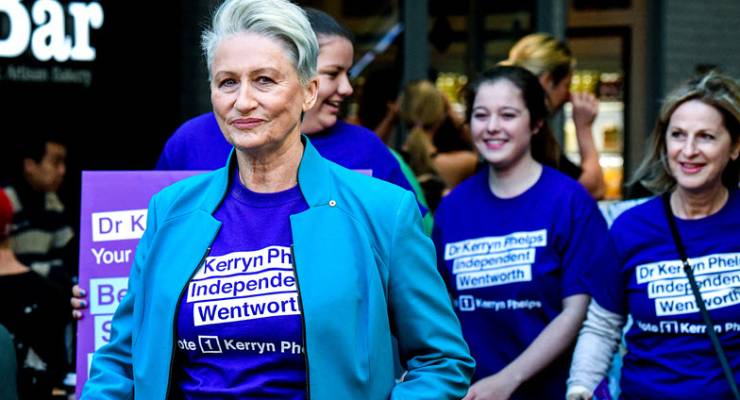
The overhaul, by independent Kerryn Phelps, of a nominally very safe Liberal Party seat in Wentworth takes in many factors. A popular and high profile independent running after the popular and high profile local member had been axed by his own party and a truly disastrous week for the government leading up to the poll cannot be ignored.
But if the loss also reflects the hastening decay of trust in the major parties across the board, what does that mean for upcoming elections?
Bernard Keane observed in these pages that Wentworth, regardless of the outcome showed previously safe seats were in play in the modern context, and before that, Guy Rundle predicted a “dozen prominent people who can win in places where the Greens can’t” could be enough to reshape Australian politics.
Could the majors be be facing more successful challenges from independents, and if so, where would it be?
Danielle Wood, program director of budget policy and institutional reform at the Grattan Institute has written of the crisis of trust in politics and the protest politics that will inevitably follow. Wood says there are certain characteristics that make a seat more vulnerable to attack from an independent or minor party.
“Regional seats are particularly vulnerable to a protest vote. In the 2016 election of the nine seats where an independent or minor party candidate received in excess of 20% of the primary vote, seven were in regional areas, two were in metropolitan areas — Denison and Sturt” she told Crikey. “Or if we look at seats with a total minor party/independent primary vote in excess of 30%, 12 were in regional areas compared to two — Denison, Port Adelaide — in metropolitan areas.”
Here are five seats to keep an eye on next year.
Higgins
The seat once held by Harold Holt, John Gorton and Peter Costello typifies the emerging phenomenon of the blue-green inner urban electorate. The Greens outpolled Labor to make the final count for the first time in 2016, and went one better to poach the partly corresponding seat of Prahran from the Liberals at the state election in 2014. The Liberals do have an asset in locally popular incumbent Kelly O’Dwyer, and can be very grateful that nothing came of a mad scheme to have her dumped in favour of Peta Credlin.
Macnamara
If Malcolm Turnbull was still at the helm, the seat known until now as Melbourne Ports would offer the Liberals a beguiling opportunity for a gain to offset likely losses elsewhere. The seat is in many ways a Melbourne equivalent of Wentworth, mixing wealth and inner-city bohemianism, and boasting large Jewish and LGBTIQ populations.
However, its components balance in a way that makes it a Labor rather than a Liberal seat — but one where Labor has been losing ground to both Liberals and the Greens, and came closer to defeat in 2016 than at any time in over a century. With long-serving incumbent Michael Danby about to retire, 2019 was shaping up as the Liberals’ big chance. That looks dead and buried now, regardless of what gimmicks the Morrison government might conjure to win over the Jewish vote.
Reid
It was a measure of the miserable state of the Labor brand in New South Wales at the time of the 2013 election that they lost this inner west Sydney seat for the first time in its history. But it was a measure of Malcolm Turnbull’s appeal in affluent, young, ethnically diverse inner urban areas that the Liberals retained the seat in the more difficult circumstances of 2016. If the Liberals have a prayer of making it three in a row, that will surely be down to its Turnbull arch-loyalist member, Craig Laundy — assuming he chooses to stick around, which seems very far from certain.
Ryan
Whatever Liberal National Party preselectors had in mind when they dumped pro-Turnbull incumbent Jane Prentice for young male conservative Julian Simmonds, it wasn’t the sensibilities of an electorate whose inner urban profile gives it a lot in common with Wentworth. Were Prentice of a suitably rebellious frame of mind, she could probably hold it as an independent. Failing that, there has to be at least some concern of Labor pulling off a repeat of its byelection win in 2001, despite the outwardly secure 9% margin.
Brisbane
The leafy inner urban suburbs of Clayfield and Ascot have been pivotal to the LNP’s success in this seat over three successive elections, outweighing Labor’s strength in the suburbs immediately to the city’s north. A substantial loss of support in the former area would make the seat difficult for sitting member Trevor Evans to defend. Then there’s the threat of the Greens, who have been on the march in inner Brisbane at recent state and council elections — and whose candidate in Brisbane will be Andrew Bartlett, who returned to the limelight last year when he filled Larissa Waters’ section 44 vacancy in the Senate.
***
Of course location plays a part, but doesn’t take into account what really makes candidates like Phelps dangerous.
“What makes a seat most vulnerable is a local candidate with some brand recognition putting up their hand,” Wood said. “The vote for minor parties and independents is predominantly a protest vote — a vote for ‘anyone but them’,” she said. “High profile local candidates provide a lightning rod for this dissatisfaction. So can minor parties with a big name leaders.
“Successful independents and minor parties differ in terms of policy and style but what they almost always have in common is a promise to ‘drain the billabong’ and make governments more accountable.”
As such Labor can relax, but, as Macnamara illustrates, maybe not for long.
“I expect whoever is in government is particularly vulnerable to this type of vote but I don’t think Labor will be entirely be off the hook,” Wood said.
Which seats do you think will fall in 2019 to independents? Email boss@crikey.com.au and let us know.









Don’t be so sure that Kelly O’Liar will survive the 2019 poll. Her ministerial gigs to date have not left her “covered in glory”.
Don’t be surprised if Phelps can’t hold Wentoworth in a General Election. I’m not wishing it to happen, just reflecting on Labor’s loss of Ryan in 2001, and the Greens’ inability to hold Cunningham in 2004(?)
What about Waringah NSW? Any chance of a strong independent turfing out the reviled Tony Abbot?
Tony Abbott in Warringah must be wondering
Oh ! please, please let there be an independent of intelligence and integrity who can wrest the seat of Dickson from Spud Dutton.
I reckon Craig Laundy will hang onto Reid if he contests it. The factor this analysis leaves out is shifting boundaries. I used to live in the seat of Reid. Without moving house I have moved from Reid to Blaxland and then to MacMahon. Reid lost some of the traditional Labor areas to the west and south and gained more Liberal voting areas to the east and north. The electorate as a whole has shifted a long way to the east and north since the days Tom Uren held it. It now includes suburbs like Strathfield, Burwood, Newington, Canada Bay, Cabarita, Five Dock, Drummoyne and so on and so forth. These are not working class suburbs and many are waterfront. So it was no surprise to me that Craig won the seat for the Liberals. But I think, since winning office, he has proved himself to be almost an anti-politician, in the good sense. I reckon his popularity would have soared over his principled stand in recent months. I could probably never bring myself to vote Liberal, but with Craig I would be tempted.
I just looked it up. The old division of Reid was abolished in 2009. The old division of Lowe was renamed to Reid. At the time, Lowe/Reid was a marginal Labor seat.
https://www.aph.gov.au/About_Parliament/Parliamentary_Departments/Parliamentary_Library/pubs/rp/rp1718/Quick_Guides/FederalRedistributions